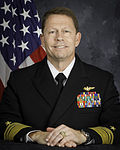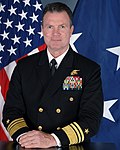Top Qs
Timeline
Chat
Perspective
List of United States Navy vice admirals from 2010 to 2019
From Wikipedia, the free encyclopedia
Remove ads
The rank of vice admiral (or three-star admiral) is the second-highest rank normally achievable in the United States Navy, and the first to have a specified number of appointments set by statute. It ranks above rear admiral (two-star admiral) and below admiral (four-star admiral).

vice admiral
There have been 120 vice admirals in the U.S. Navy from 2010 to 2019, 20 of whom were promoted to four-star admiral. All 120 achieved that rank while on active duty in the U.S. Navy. Admirals entered the Navy via several paths: 75 were commissioned via the U.S. Naval Academy (USNA), 27 via Naval Reserve Officers Training Corps (NROTC) at a civilian university, five via Officer Candidate School (OCS), four via Aviation Officer Candidate School (AOCS), four via direct commission (direct), one via NROTC at a senior military college, one via the U.S. Air Force Academy (USAFA), and one via direct commission inter-service transfer from the United States Army (USA).
Remove ads
List of admirals
Summarize
Perspective
Entries in the following list of vice admirals are indexed by the numerical order in which each officer was promoted to that rank while on active duty, or by an asterisk (*) if the officer did not serve in that rank while on active duty. Each entry lists the admiral's name, date of rank,[a] active-duty positions held while serving at three-star rank,[b] number of years of active-duty service at three-star rank (Yrs),[c] year commissioned and source of commission,[d] number of years in commission when promoted to three-star rank (YC),[e] and other biographical notes.[f]
Remove ads
Timeline
2010–2019

Background
Summarize
Perspective
Three-star positions, elevations and reductions

Several three-star positions were created, consolidated, or even eliminated entirely between 2010 and 2019.
- The warfighting development (OPNAV N7) directorate was stood up in October 2019 to develop and disseminate naval strategy and implement it in tandem with naval training and education efforts.[24][25] Rear Admiral Stuart B. Munsch was promoted to vice admiral to become the first deputy chief of naval operations for warfighting development.[26][24]

- The warfare systems (OPNAV N9) directorate was stood up in 2012 for validating and integrating requirements and resources for manpower, training, sustainment safety and modernization of manned and unmanned warfare systems of the U.S. Navy,[27] with Vice Admiral William R. Burke as its inaugural commander.
- The surgeon general of the Navy (SGN), a vice admiral's billet since 1965 was reduced to a rear admiral's billet after the 2017 National Defense Authorization Act struck the statutory ranks of heads of restricted/limited-duty communities.[28] Rear Admiral Bruce L. Gillingham, the first Navy surgeon general since passage of the Act, assumed office on 1 October 2019.[26]
- Naval Information Forces (NAVIFOR), established in 2014 as a two-star command[29] was elevated to a three-star command in July 2017.[20] Then-NAVIFOR commander, Rear Admiral Matthew J. Kohler was promoted to vice admiral on 6 July 2017.[20][30]
- United States Second Fleet (COMSECONDFLT) was disestablished and re-established in 2011 and 2018.
- In September 2011, Second Fleet was disestablished and merged with the U.S. Fleet Forces Command as a cost-saving measure. COMSECONDFLT's directorship of the Combined Joint Operations from the Sea Center of Excellence (CJOS COE), held since 2006, was transferred to the deputy commander of U.S. Fleet Forces Command.[31][32]
- Facing maritime competition from Russia, Second Fleet was formally re-established on 24 August 2018[33] as a strategic countermeasure. Its new commander, Vice Admiral Andrew L. Lewis was dual-hatted as Joint Force Command - Norfolk (JFC-NF) from June 2018, and re-assumed the directorship of CJOS COE in October 2020.[21][34]
Senate confirmations

Military nominations are considered by the Senate Armed Services Committee. While it is rare for three-star or four-star nominations to face even token opposition in the Senate, nominations that do face opposition due to controversy surrounding the nominee in question are typically withdrawn. Nominations that are not withdrawn are allowed to expire without action at the end of the legislative session.
- For example, the nomination of Rear Admiral Elizabeth L. Train for promotion to vice admiral and assignment as director of naval intelligence and deputy chief of naval operations for information warfare was withdrawn in April 2016[35] in favour of Vice Admiral Jan E. Tighe, then-commander of U.S. Fleet Cyber Command and Tenth Fleet.[36] Tighe was confirmed in May 2016[37] and assumed office in July 2016.[38]
- The nomination of Major General Ryan F. Gonsalves for promotion to lieutenant general and assignment as commanding general of U.S. Army Europe was withdrawn in November 2017[39] after an investigation was launched into the general's inappropriate comment to a female Congressional staffer.[40] As a result, Gonsalves was administratively reprimanded and retired in May 2018.[40][41][42]
Additionally, events that take place after Senate confirmation may still delay or even prevent the nominee from assuming office.
- For example, Major General John G. Rossi, who had been confirmed for promotion to lieutenant general[43] and assignment as the commanding general of the U.S. Army Space and Missile Defense Command in April 2016[44] committed suicide two days before his scheduled promotion and assumption of command.[45] As a result, the then incumbent commander of USASMDC, Lieutenant General David L. Mann, remained in command beyond customary term limits until another nominee, Major General James H. Dickinson was confirmed by the Senate.[46]
- Vice Admiral Scott A. Stearney assumed command of U.S. Naval Forces Central Command, Fifth Fleet, and Combined Maritime Forces in May 2018.[47] His death in December of the same year resulted in the speedy confirmation[48] of Rear Admiral James J. Malloy in the same month for appointment to three-star rank as his replacement.[49]
Remove ads
Legislative history
Summarize
Perspective
The following list of Congressional legislation includes all acts of Congress pertaining to appointments to the grade of vice admiral in the United States Navy from 2010 to 2019.[s]
Each entry lists an act of Congress, its citation in the United States Statutes at Large or Public Law number, and a summary of the act's relevance, with officers affected by the act bracketed where applicable. Positions listed without reference to rank are assumed to be eligible for officers of three-star grade or higher.
Remove ads
See also
- List of active duty United States four-star officers
- List of active duty United States three-star officers
- List of United States Navy vice admirals on active duty before 1960
- List of United States Navy vice admirals from 2000 to 2009
- List of United States Navy vice admirals since 2020
- List of United States Coast Guard vice admirals
- List of United States Public Health Service Commissioned Corps vice admirals
- List of United States military leaders by rank
- List of United States Navy four-star admirals
- Vice admiral (United States)
Remove ads
References
Bibliography
External links
Wikiwand - on
Seamless Wikipedia browsing. On steroids.
Remove ads






















































































































